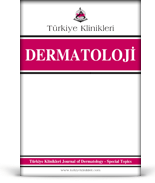Epidermal büyüme faktörü reseptör inhibitörleri (EBFR-İ), birçok solid organ malignitelerinde tedavide kullanımı nispeten yeni sayılabilecek bir grup ilaçlardır. Standart kemoterapi rejimleri replikasyon gösteren çoğu hücreyi hedef alırken, EBFR-İ çoğunlukla kanser hücrelerinin bölünmesinde ve çoğalmasında görev alan yolakları hedef alır. Bununla birlikte keratinosit, sebosit, saç folikülü hücreleri gibi malign olmayan hücrelerin normal hücresel büyüme ve farklılaşma sürecinde de EBFR görev almaktadır. EBFR-İ kullanımı ile kutanöz yan etkilerin görülme sıklığı %80'in üzerindedir. Bu yan etkilerden; akneiform döküntü, eritem, kserozis, fissürler, pruritus, tırnak değişiklikleri (onikolizis, piyojenik granülom, paronişi) sıklıkla sözü geçen durumlardır. Ayrıca saç değişiklikleri, mukozit, fotosensitivite, telenjiyektazi, hiperpigmentasyon, mukokutanöz hemoraji, gecikmiş yara iyileşmesi, konjunktivit ve blefarit ile prezente olabilen göz tutulumu bildirilmiştir. Kutanöz yan etkilerin olup olmamasının, surviyi belirlemede bir prediktif değeri olabileceği belirlenmiştir. Bu yazıda, setuksimaba bağlı farklı şiddette 1'den fazla kutanöz yan etki gelişen 2 farklı kadın olgu sunulmaktadır.
Anahtar Kelimeler: Akneiform erüpsiyonlar; blefarit; konjonktivit; paronişi; setuksimab
Epidermal growth factor receptor inhibitors (EGFR-I) are a group of drugs that can be considered new to compare their use in the treatment of many solid organ malignancies. While standard chemotherapy regimens target most of the replicating cells, EGFR-I mostly target the pathways involved in the proliferation of cancer cells. However, EGFR is also involved in the normal cellular growth and differentiation process of non-malignant cells such as keratinocytes, sebocytes, and hair follicle cells. The frequency of cutaneous side effects with the use of EGFR-I is over 80%. Among these side effects, acneiform rash, erythema, xerosis, fissures, pruritus, nail changes (onycholysis, pyogenic granuloma, paronychia) are frequently mentioned. In addition; hair changes, mucositis, photosensitivity, telangiectasia, hyperpigmentation, mucocutaneous hemorrhage, delayed wound healing, eye involvement that may present with conjunctivitis and blepharitis have been reported. It has been indicated that the presence or absence of cutaneous side effects may have a predictive value in determining the survival of patients. In this article, two different female cases who developed more than one cutaneous side effect of different severity due to cetuximab are presented
Keywords: Acneiform eruptions; blepharitis; conjunctivitis; paronychia; cetuximab
- DeWitt CA, Siroy AE, Stone SP. Acneiform eruptions associated with epidermal growth factor receptor-targeted chemotherapy. J Am Acad Dermatol. 2007;56(3):500-5. [Crossref] [PubMed]
- Chan DLH, Segelov E, Wong RS, Smith A, Herbertson RA, Li BT, et al. Epidermal growth factor receptor (EGFR) inhibitors for metastatic colorectal cancer. Cochrane Database Syst Rev. 2017;27;6(6):CD007047. [Crossref] [PubMed] [PMC]
- Lacouture ME. Mechanisms of cutaneous toxicities to EGFR inhibitors. Nat Rev Cancer. 2006;6(10):803-12. [Crossref] [PubMed]
- Ocvirk J, Cencelj S. Management of cutaneous side-effects of cetuximab therapy in patients with metastatic colorectal cancer. J Eur Acad Dermatol Venereol. 2010;24(4):453-9. [Crossref] [PubMed]
- Segaert S, Van Cutsem E. Clinical signs, pathophysiology and management of skin toxicity during therapy with epidermal growth factor receptor inhibitors. Ann Oncol. 2005;16(9):1425-33. [Crossref] [PubMed]
- Karagün E, Eşbah O. Dermatological side-effects developing in patients using targeted chemotherapy drugs: a review of the literature. Journal of Medical Investigation. 2020;4(2):173-80. [Crossref]
- Beech J, Germetaki T, Judge M, Paton N, Collins J, Garbutt A, et al. Management and grading of EGFR inhibitor-induced cutaneous toxicity. Future Oncol. 2018;14(24):2531-41. [Crossref] [PubMed]
- Petrelli F, Borgonovo K, Barni S. The predictive role of skin rash with cetuximab and panitumumab in colorectal cancer patients: a systematic review and meta-analysis of published trials. Target Oncol. 2013;8(3):173-81. [Crossref] [PubMed]
- Gürbüz M, Akkuş E, Utkan G. Topical aloe vera for the treatment of cetuximab-related acneiform rash in colorectal cancer: a case report. J Oncol Pharm Pract. 2020;5:1078155220937751. [Crossref] [PubMed]
- Andrews ED, Garg N, Patel AB. A retrospective chart review on oral retinoids as a treatment for epidermal growth factor receptor inhibitor- and mitogen-activated protein kinase kinase inhibitor-induced acneiform eruptions. J Am Acad Dermatol. 2020;82(4):998-1000. [Crossref] [PubMed]
- Cubiró X, Planas-Ciudad S, Garcia-Muret MP, Puig L. Topical Timolol for paronychia and pseudopyogenic granuloma in patients treated with epidermal growth factor receptor inhibitors and capecitabine. JAMA Dermatol. 2018;1;154(1):99-100. [Crossref] [PubMed] [PMC]
- Califano R, Tariq N, Compton S, Fitzgerald DA, Harwood CA, Lal R, et al. Expert consensus on the management of adverse events from EGFR tyrosine kinase inhibitors in the UK. Drugs. 2015;75(12):1335-48. [Crossref] [PubMed] [PMC]
- Olamiju B, Bhullar S, Coleman EL, Leventhal JS. Management of paronychia with pseudopyogenic granulomas secondary to epidermal growth factor receptor inhibitors: an assessment of topical timolol and the need for multiple medical and procedural therapies. J Am Acad Dermatol. 2020;11:S0190-9622(20)31070-7. [PubMed]
- Kılıç A. [Inhibitors of epidermal growth factor receptor and dermatological side effects]. Turk J Dermatol. 2012;6(4):168-74. [Crossref]
- Dranko S, Kinney C, Ramanathan RK. Ocular toxicity related to cetuximab monotherapy in patients with colorectal cancer. Clin Colorectal Cancer. 2006;6(3):224-5. [Crossref] [PubMed]







.: Process List